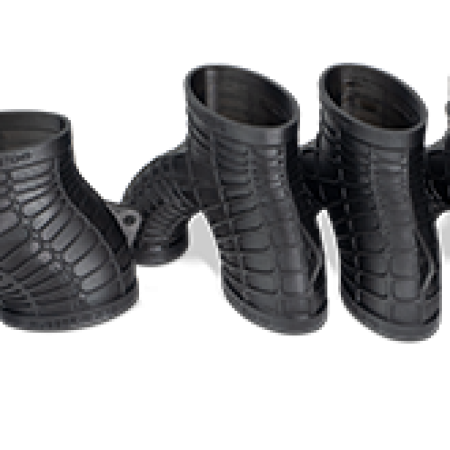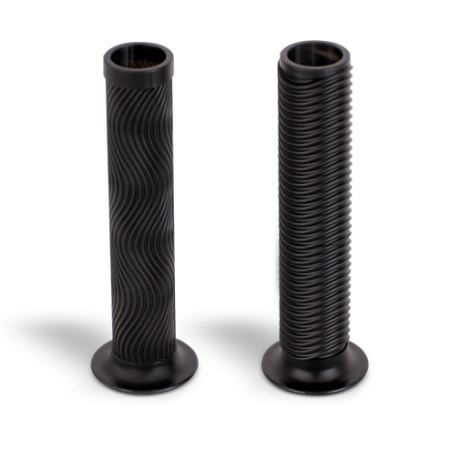Hankook Tire & Technology is more than a tire manufacturer. With a focus on automation and technology that will enable “The Future Driving Innovator,” the Seoul-based company has put electrical vehicles at the center of what they do. Recently, Hankook needed a way to quickly and cost-effectively drive innovation by iterating multiple plastic and elastomeric designs with complex geometries for its i-Flex nonpneumatic tire (NPT), which would eventually become a key component in Hankook’s award-winning HPS-Cell autonomous mobility platform. By leveraging 3D Systems’ plastic and elastomer additive manufacturing technologies, Hankook’s Design Studio was able to quickly iterate designs and share production-grade parts among their designing, and testing teams while reducing costs.
“The main purpose of using 3D printing is to communicate better with R&D before they build the actual mold to produce the tire. The traditional molds are machined and cost a lot of money and time to develop, but that’s also been the conventional way to figure out a new design, shape, and even volume. Now, using additive manufacturing technologies from 3D Systems, we can work faster with R&D to figure out the shape or structure using small portions of the structure and then test our prototypes for safety, noise, and other parameters.”
- Rosa Youn, Design Innovation Studio Manager, Hankook Tire & Technology
The Challenge
Expedite multimaterial, complex tire and wheel designs and testing while cutting costs
Hankook Tire & Technology understands that autonomous mobility solutions of the future require a new generation of tires that combine minimal maintenance with maximum safety and comfort. With their low maintenance and increased safety, NPTs are predestined for this field of application but developing an NPT that checks all these boxes presented a complex and costly design challenge. Hankook designers believed that a biomimetic design that mimicked biological tissues would provide internal support for the NPT, but with a nearly infinite number of possible cellular structure designs, Hankook’s Design Studio needed a way to quickly evaluate partial parts as well as scale complete models.
Traditional prototyping methods for new tires often started with a 2D sketch, transitioning to a 3D CAD design that would be translated into an aluminum mold through skilled human machinists. The entire process was too costly and too slow, with each iteration taking potentially weeks or months.
Furthermore, the NPT’s biomimetic supporting “spokes” matrix challenged even the most capable machining stations due to its complex hollow, interconnected structures. After exploring multiple additive systems for rapid prototyping and low-volume production, Hankook chose 3D Systems’ Figure 4 technology platform for the plastic support structures and rubber tread. Hankook also turned to 3D Systems’ partner CEP Tech for selective laser sintering (SLS) for conepting the metal tire structures and hinges, which turbocharged the development of their i-Flex NPT prototypes. The result, as Hankook designers like to say, is the future of mobility.
The Solution
1 – Spoke Structures for Nonpneumatic Tire i-Flex
Various iterations and concepts of spokes printed with 3D Systems additive manufacturing technologies (r) that led to the final design of the Hankook HPS Cell (L)
Hankook’s NPT tire includes a complex biomimetic plastic matrix for internal support, an elastomeric external tire tread, and metal parts that perform some of the support functions of a tire rim plus additional functions necessary for autonomous vehicles. Machining these hollow structures in plastic would be nearly impossible.
“For us, because of [3D Systems’] additive manufacturing technologies, we can design or make anything we want to or anything we can imagine. This technology can eliminate the limits of manufacturing, which is really great for us. With traditional product design for example, building and machining, there are a lot of limits. Machine tools have limits. Additive manufacturing does not have these limits,” said Hee Sung Jang, Design Innovation Studio Designer, Hankook Tire & Technology.
Using the Figure 4 platform, Hankook designers are able to quickly iterate different support matrices using Figure 4 PRO-BLK 10 plastic with its thermoplastic-like mechanical properties. The Hankook Design Studio team could quickly turn 3D designs of different biomimetic matrixes into partial or scaled prototypes that maintain the same cellular spacing ¬— which is critically important to downstream testing — all while constraining development costs. With partial parts that include full-scale cellular structures, Design Studio designers could quickly gauge relative strengths among candidate designs using physical testing before proceeding into full tire assembly.
2 – Noise Control Testing on Tire Segments
Tires, including NPT tires, need to be safe and durable, but they also need to be aesthetically and acoustically pleasing. In short, people won’t buy ugly tires, and they won’t keep buying loud tires. After developing the NPT support matrix, Hankook Design Studio designers were able to develop partial and scaled tread designs using Figure 4 RUBBER-65A BLK elastomeric materials.
“By using those materials and partial parts, we can evaluate the part for noise and safety,” said Mrs. Youn. “The test system flows air or water into the channel or groove, [and] we measure the noise to understand if the structure is correct or not.” She added that in the future, building these treads in translucent Figure 4 material will make the process even easier, allowing engineers to see how fluid travels down the tread grooves, a key part of tire safety in adverse weather.
Additionally, printing tire treads makes it easy for manufacturing engineers to evaluate new NPTs for stability and potential cracking and reduced reliability.
Hankook’s NPT design includes plastic components for internal support, rubber materials for tire tread, and metal components for tire rim and support. All three elements are shown here.
3 - Moving Parts on New Concept–Type Tires
Additive manufacturing’s ability to develop complex shapes also allowed Hankook designers to develop internal grooves and structures that help connect the tires’ three primary elements: tread, NPT support matrixes, and moving thermoplastic rim components. The thermoplastic components were manufactured by CEP Tech, using 3D Systems’ SLS technology. This was new to Hankook, as traditional tires don’t consist of any moving parts.
“One of the main reasons we chose 3D Systems over the competition is that their material selection is so broad,” said Rosa Youn, Design Innovation Studio Manager, Hankook Tires. “It covers all the material requirements we have. In addition the Figure 4 is fast. Time saving, reliability, service, best troubleshooting, and also availability of the system and reasonable price were our key decision factors. We believe in the value of 3D Systems’ Figure 4. For me it is one of the best additive manufacturing systems in the world.”
4 - Standard Visual Prototypes of Tire Profiles
Hankook Design Studio has already expanded the use of the Figure 4 platform, using it to develop traditional tire treads and profiles for testing. This is allowing for faster iterations of all new product designs, not just the revolutionary but the evolutionary as well.
In addition to helping Hankook’s Design Center quickly develop and test NPT tire designs, the company can also use it to quickly evaluate new tread designs for road noise and other key factors, reducing time to market and costs for all new tire designs at Hankook.
Additive Manufacturing Lab at the Hankook Design Center with its fleet of Figure 4 Standalone printers that enable the company to accelerate innovation with parts in hand within minutes and hours.


